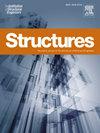Study on the mechanical properties of hybrid bonding shear connections with shear studs and epoxy mortar layer
IF 3.9
2区 工程技术
Q1 ENGINEERING, CIVIL
引用次数: 0
Abstract
This paper designed a new type of hybrid bonding (HB) shear connections consisting of both epoxy mortar layer and shear studs, to avoid the shortcomings such as stress concentrations and welding defects accompanied with the use of the traditional stud connectors in composite structures. In order to study the mechanical behavior of the hybrid connections in a systematic fashion, this work carried out several experimental tests, including measurement under static loads and push-out tests on specimens with epoxy-mortar shear connections and hybrid connections containing single stud and group studs, respectively. During those experiments, several parameters that affected the mechanical behavior of the connectors were investigated, such as the failure mode, interfacial slip, as well as the load-displacement relation and bonding capacity, etc. It was demonstrated that the shear capacity of the specimens with hybrid shear connection was generally higher than that with pure shear studs. What’s more, it was found that the failure/debonding could appear at interfaces between adhesive layer and steel girders/concrete structures. The aforementioned experiments illustrated that the epoxy mortar layers possessed excellent shear capacity and effectively avoided the stress concentrations by the shear studs. Regarding the post-debonding process, hybrid connections exhibited similar mechanical behavior as the shear studs within the epoxy mortar layer. In general, it is concluded that the proposed hybrid connection is superior and is recommended for the shear connection of composite structures relative to the traditional stud connectors.
带剪力螺栓和环氧砂浆层的混合粘结剪力连接的力学性能研究
本文设计了一种由环氧树脂砂浆层和剪力螺柱组成的新型混合粘接(HB)剪力连接,以避免在复合结构中使用传统螺柱连接件时产生的应力集中和焊接缺陷等缺点。为了系统地研究混合连接的机械性能,这项工作进行了多项实验测试,包括在静载荷下进行测量,以及对环氧砂浆剪切连接和包含单个螺柱和多组螺柱的混合连接试样分别进行推出测试。在这些实验中,研究了影响连接件机械行为的几个参数,如失效模式、界面滑移以及载荷-位移关系和粘接能力等。结果表明,采用混合剪切连接的试样的抗剪能力普遍高于采用纯剪切螺柱的试样。此外,实验还发现,在粘合剂层与钢梁/混凝土结构的界面处可能会出现失效/脱粘现象。上述实验表明,环氧砂浆层具有出色的抗剪能力,可有效避免剪力螺栓造成的应力集中。在后粘接过程中,混合连接表现出与环氧砂浆层内的剪力螺栓相似的机械性能。总之,与传统的剪力墙螺栓连接件相比,所提出的混合连接件更优越,建议用于复合结构的剪力连接。
本文章由计算机程序翻译,如有差异,请以英文原文为准。
求助全文
约1分钟内获得全文
求助全文
来源期刊

Structures
Engineering-Architecture
CiteScore
5.70
自引率
17.10%
发文量
1187
期刊介绍:
Structures aims to publish internationally-leading research across the full breadth of structural engineering. Papers for Structures are particularly welcome in which high-quality research will benefit from wide readership of academics and practitioners such that not only high citation rates but also tangible industrial-related pathways to impact are achieved.
 求助内容:
求助内容: 应助结果提醒方式:
应助结果提醒方式:


